There is no doubt that Glen Etive is one of the most popular glens in Scotland. It is popular with walkers, kayakers and, of course, landscape photographers. Starting around the Rannoch Moor area, the glen runs for miles in a southwest direction, before ending at Loch Etive, a fairly narrow and very long sea loch – an equally popular area for tourists to catch boat trips and experience the loch’s majestic views.
Along the glen runs River Etive, which is responsible for the drainage of a vast area that includes part of Glencoe and Rannoch Moor. The landscape along the river is ideal for allowing it to create small waterfalls, large pools and even lochs, hence the river is popular with kayakers. More to the point, due to the area’s wild charm, one can find countless photographic compositions, from wide-angle vistas to close up and macro.
I’d like to take you a bit further south though to where the sea loch starts. Loch Etive used to be extremely popular for landscape photographers also. You see, there used to be a very old and lately ruined jetty – extremely photogenic as the main subject with the extraordinary backdrop of mountains reflecting on the loch’s surface. However, with the jetty in ruins, it became really difficult for the boats to stop and allow tourists to get on land. So, the jetty was replaced with a really good looking slab of concrete – how delightful. I still remember the disappointment during my last visit there. On my way back to the car I met a fellow photographer from Italy. He was in Scotland for his photographic holidays and that jetty was a primary destination on his list.
After this, there was not much interest in visiting the loch any more. Besides, as I already said, there has been a lot of interest along the glen – until recently. I had a couple of friends visiting me from Canada and, as they wanted to see the real and wild Scotland, one of the chosen destinations was Glen Etive. We drove all the way to the sea loch and started walking along the dry moorland. Looking for potential compositions I came across this fallen tree. I couldn’t really tell if it had fallen nearby or if it had been deposited there by the river. All I knew was that, in the middle of nowhere, it looked as a superb subject to describe the area in one picture.
It was now a matter of setting up my gear. At first I tried an ultra wide-angle view. I opted for the Canon 5D Mk II and the 17mm tilt & shift lens. It became immediately obvious that the setup was far too wide, as the mountains had become tiny mole holes in the distance. I swapped cameras and this time I chose the Canon 70D with its smaller sensor, as this allowed the same lens to become a 29mm one. The final approach was to choose the format. 5x4 seemed the best choice as it allowed more of the subject (the fallen tree) to be used with just enough space for the mountains and sky. After all the technicalities were checked, it was time to wait slightly for the pre-sunset sky to do its magic.


3 Comments
Beautiful image. Can you share the particulars: lens, film, amount of tilt/shift, if any?
Hi Kevin
Thank you very much for your comment. The exif data can be found in the sidebar.
If you are viewing on a mobile device, then you need to scroll down and find the sidebar.
Dear Dimitri,
The fallen tree was in fact a standing tree when I visited two years ago. It’s sad to see the trees whic are iconic like the one in Rannoch moor etc falling. I shall be sending the image shortly.